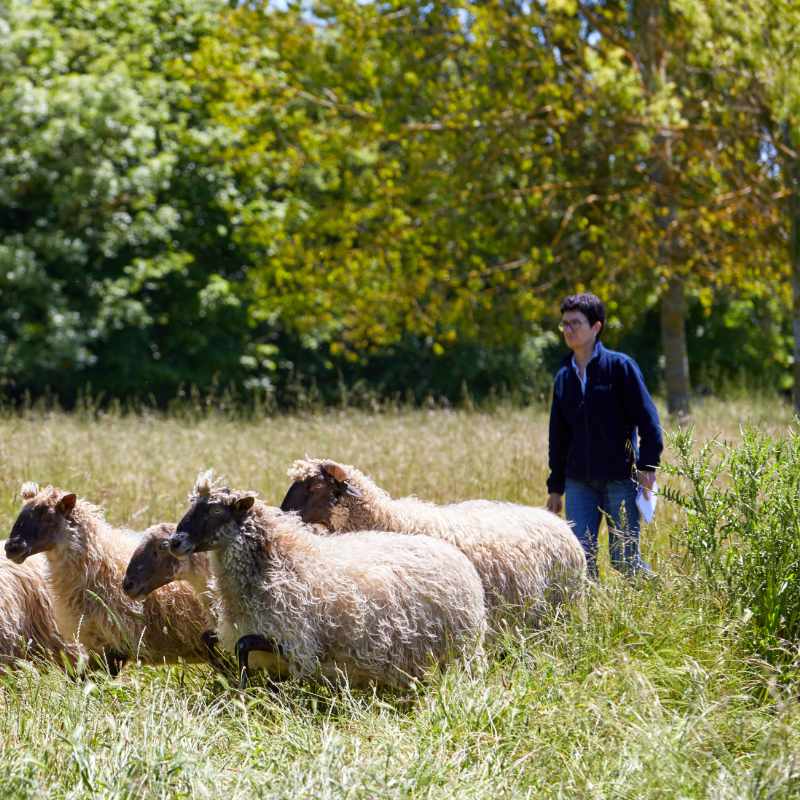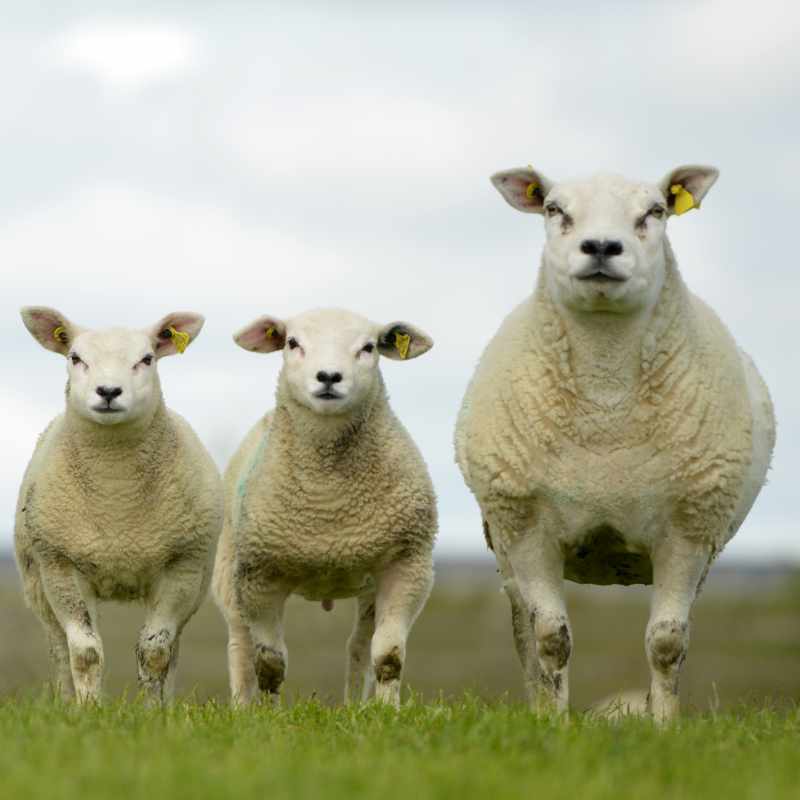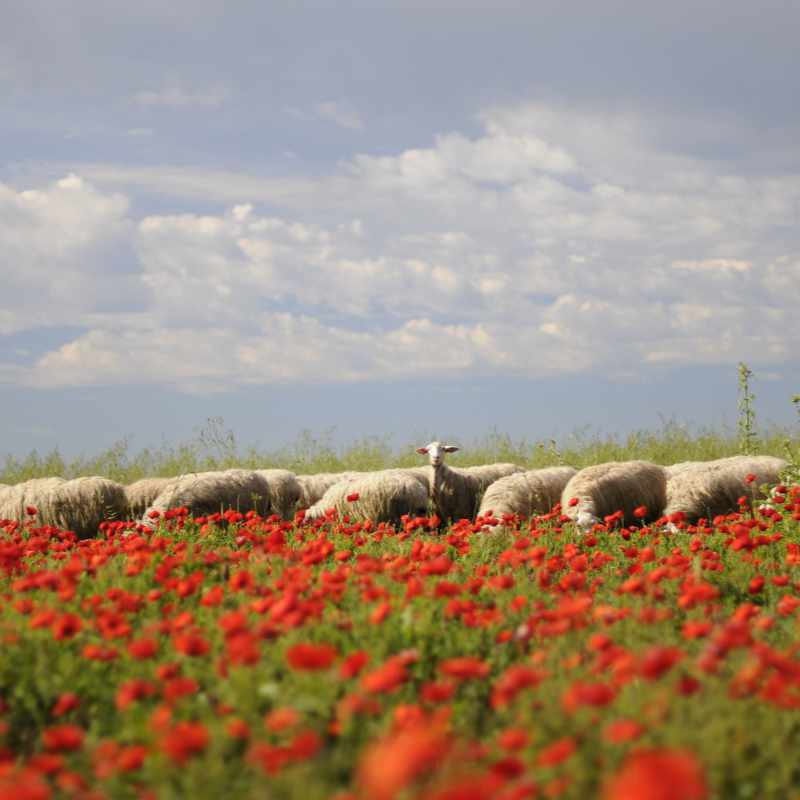AN EUROPEAN PROJECT 2020-2025
Demonstration and dissemination actions to reduce the carbon footprint in European sheep farming
Objective:
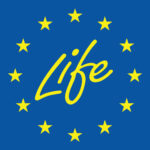 Reduce by 12% the carbon footprint of sheep milk and sheep meat while ensuring farms sustainability
Reduce by 12% the carbon footprint of sheep milk and sheep meat while ensuring farms sustainability
The project involves 5 European countries : France, Ireland, Italy, Romania and Spain which represent respectively 47% and 63% of the EU sheep meat and sheep milk production
Context
 Small ruminants, in particular sheep farmed for milk and meat production, produce greenhouse gasses (GHG) through their physiological digestive processes.
Small ruminants, in particular sheep farmed for milk and meat production, produce greenhouse gasses (GHG) through their physiological digestive processes.
These emissions represent 7.4% of global GHG emissions from anthropogenic activities (FAO, 2017).
However, studies show that farmers have little knowledge of how to reduce GHG emissions.
![]() On the other hand, sheep farming can regulate the climate by storing carbon in grasslands and hedgerows among others. This gives sheep farming an important role in mitigating climate change and keeping farms viable. Finally, studies carried out up to now in Europe show that things can be done among sheep farms, thanks to a significant variability in practices.
On the other hand, sheep farming can regulate the climate by storing carbon in grasslands and hedgerows among others. This gives sheep farming an important role in mitigating climate change and keeping farms viable. Finally, studies carried out up to now in Europe show that things can be done among sheep farms, thanks to a significant variability in practices.
 Therefore, these are the challenges of the LIFE GREEN SHEEP project, which objective is to reduce the carbon footprint of sheep meat and sheep milk by 12% within 10 years, while ensuring the farms’ sustainability, in 5 countries (France, Ireland, Italy, Romania and Spain).
Therefore, these are the challenges of the LIFE GREEN SHEEP project, which objective is to reduce the carbon footprint of sheep meat and sheep milk by 12% within 10 years, while ensuring the farms’ sustainability, in 5 countries (France, Ireland, Italy, Romania and Spain).
Actions
Action 1: DEVELOPMENT
Review, benchmark and harmonise the tools for evaluating GHG emissions and sustainability indicators at a European scale
Tools tested: CAP’2ER® (France, Italy and Romania); ArdiCarbon (Spain); SheepLCA (Ireland) and CarbonSheep (Italy).
- Task 1: Development of a common methodology to assess GHG emissions
-
- Qualitative comparison of the tools (methodology, scope of assessment, functional unit, allocation, emission factors, technical data needed.etc.)
-
- Quantitative comparison of the tools: 3 cases study per production system (dairy sheep, meat sheep) and for each country involved in the project.
- Task 2: Development of a common methodology to assess sustainability performance production
-
- Inventory of existing methods/indicators
- Choice of common indicators based on existing tools: DEO (France), ArdiCarbon (Spain) and the tool developed within H2020 iSAGE project.
- Task 3: Building and updating tools
-
- Adaptation of the CAP’2ER® tool to the Romanian and Italian systems
- Implementation of emission factors, equations, new indicators (if needed), integration of parameters adapted to the country context
- Task 4: Bibliography review and synthesis on the action levers.
 Review, benchmark and harmonise the tools for evaluating GHG emissions and sustainability indicators at a European scale
Review, benchmark and harmonise the tools for evaluating GHG emissions and sustainability indicators at a European scale
Action 2: TRAINING
Raise awareness and train advisors and technicians on the tools: background, methodologies, analysis of the results and construction of action plans.
- Task 1: Development of a harmonized training kit, which must include: a presentation of the context and of the project, a presentation of the tools, of the data collection module, guidelines on the results analysis and interpretation, communication strategies and potential mitigation techniques.
- Task 2: Organization of training sessions for 143 advisers (on-line/physical meetings / combined meetings) .
 Raise awareness and train advisors and technicians on the tools: background, methodologies, analysis of the results and construction of action plans.
Raise awareness and train advisors and technicians on the tools: background, methodologies, analysis of the results and construction of action plans.
Action 3: DEMONSTRATE
Creation of a EU observatory of environmental and sustainability performance and reference sheets presenting these results by type of system and by region.
This action will allow a 5% GHG emission reduction target at the end of the project for these Demonstrative farms.
- Task 1: Constitution of a sample of 1,355 Demonstrative farms
-
- each type of system will be sufficiently represented in number and the sample will notably include high school training farms.
- each type of system will be sufficiently represented in number and the sample will notably include high school training farms.
- Task 2: Deployment of a simple assessment on the 1,355 demonstrative farms in Europe.
- Task 3: Analysis and synthesis of results:
-
- determine the level of environmental efficiency and sustainability of farms
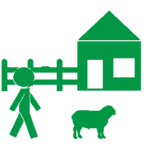 Creation of a EU observatory of environmental and sustainability performance and reference sheets presenting these results by type of system and by region.
Creation of a EU observatory of environmental and sustainability performance and reference sheets presenting these results by type of system and by region.
Action 4: INNOVATE
Assessment of environmental and sustainability performance of a sample of farms (known as Innovative farms), development and promotion of low-carbon farms by demonstrating the feasibility of action levers in real conditions.
The purpose will be to assess the technical, environmental and economic benefits of adopting these reduction practices at the farm level and verifying the achievement of the 12% reduction objective for these farms.
- Task 1: Constitution of the sample of the 282 Innovative farms in Europe
-
- each type of system will be represented, and the sample will notably include high school training farms and experimental farms.
- each type of system will be represented, and the sample will notably include high school training farms and experimental farms.
- Task 2, 3 and 4: Deployment of a detailed assessment on the 282 Innovative farms in Europe.
- Task 5: Analysis and summary of results, calculation of environmental, economic and social gains:
-
- analysis of the results of the 1st and 2nd diagnosis,
- calculations of GHG savings obtained against the -12% target,
- calculations of other environmental, economic and social gains,
- prioritization of action levers by increasing production systems and pedoclimatic conditions,
- summary of action plans, their impacts, feasibility and limits.
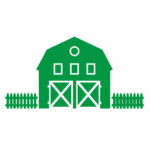 Assessment of environmental and sustainability performance of a sample of farms (known as Innovative farms), development and promotion of low-carbon farms by demonstrating the feasibility of action levers in real conditions.
Assessment of environmental and sustainability performance of a sample of farms (known as Innovative farms), development and promotion of low-carbon farms by demonstrating the feasibility of action levers in real conditions.
Action 5: PROMOTE
OBJECTIVE:
Synthesis and formalization of all the knowledge acquired through this LIFE Green Sheep project, and definition of the national communication strategy and the partnerships to be built for the deployment of a carbon plan and sustainable development for all upstream stakeholders.
- Task 1: National action plans
-
- list the levers identified in Action 4 and summarize their advantages/limits and impacts,
- develop a national action plan.
- Task 2: Acceptability of the approach by farmers and advisers conducting online surveys on the approach implemented.
- Task 3: Implementation of a partnership strategy with the aim of disseminating national action plans:
-
- identify the arguments to put forward to promote the action plans and the approach,
- integrate these new aspects into the advice process
- build the strategy to increase the number of advisers and breeders involved and create new partnerships.
 Synthesis and formalization of all the knowledge acquired through this LIFE Green Sheep project, and definition of the national communication strategy and the partnerships to be built for the deployment of a carbon plan and sustainable development for all upstream stakeholders.
Synthesis and formalization of all the knowledge acquired through this LIFE Green Sheep project, and definition of the national communication strategy and the partnerships to be built for the deployment of a carbon plan and sustainable development for all upstream stakeholders.
